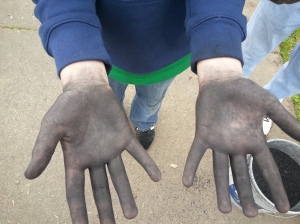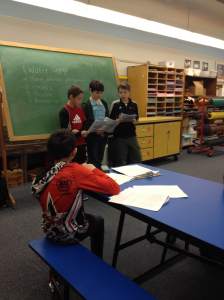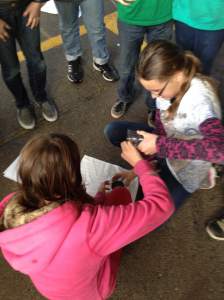Education Programs
April 10, 2015: Science Friday – GPS Navigation
At today’s Science Friday lesson we learned all about GPS (or Global Positioning Systems)! We learned about satellites, directional differentiation, how to read and input coordinates, & navigation. We ended the lesson with a geocaching activity on McGovern’s campus!

The students used their GPS units to navigate to 5 hidden caches with clues that helped them complete their food web activities!
Great job today, scientists!! Remember – next week is our very last Science Friday! See you there.
March 20, 2015: Science Friday – Understanding Biochar
Today, with the help of local Biochar experts M A Hansen, Jim Long, and Scott McCain, we learned about and experimented with biochar!
The students were introduced to different techniques to create biochar, and they were shown how to conduct various tests which proved the importance of biochar as a soil amendment. We even made our own char and used it as a pencil to create simply beautiful artwork.
March 13, 2015: Science Friday – Food System Science

Courtney explains the complicated components of the food system, while Jon, our Science Friday Student Mentor volunteer, writes down discussion points on the board.
Today we learned all about food systems! Courtney Pidgeon, the AmeriCorps Healthy Communities Leader from Phoenix Charter School, led this lesson.
We learned of the chronological significance of the various steps of the food system:
Resources → Production → Transportation → Processing → Marketing/Retailing → Eating → Waste.
The end products of the system can have various fates. They can be thrown away as solid waste, recycled, or used as compost. Compost is especially valuable to future farming and production processes. Compost is important for soil nutrition and helps contribute to future resources.
Thank you for teaching us about the wonders of our food system, Courtney!!!

We made ice cream by adding salt to the ice in our baggies, which lowered the freezing point in the bag. This allowed the mixture to get cold enough to freeze the sugared cream.
March 6, 2015: Science Friday – Forest Ecology & Food Webs
How awesome was Science Friday today?!! We learned about old growth forests, wildlife diversity, food webs, trophic levels, prey identification, and Oregon’s native species. Whew! I can barely believe we were able to fit all of that into our 2-hour time-frame!
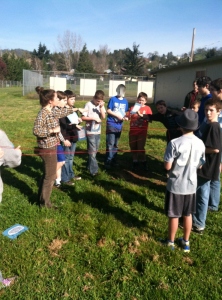
A lot of food chains make a big, complicated food web! We were each given a card of an animal, plant, or forest feature. After reading the description of their card out loud, the students used a ball of yarn to pass to another student who had a direct connection to themselves. The activity continued until all of the students were connected into 1 large food web!
Today we learned about the main structures of an old-growth forest: large, live trees, large standing snags, large, fallen trees and a multiple-layered canopy. We learned about animal and plant interactions with each other and various forest features.
We also dissected owl pellets!!! Pellets are the undigestible remains of the food eaten by owls (ours were from the common barn owl). Instead of being excreted with their other waste materials, these are regurgitated through the mouth as a mass of hair, bones, teeth, beaks, and claws.

What type of prey did this barn owl eat? Was it a deer mouse? Or perhaps it was a shrew? Let’s study the skeletal anatomy and find out!!
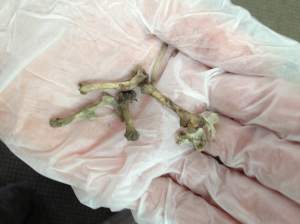
The students dissected and identified several common bones: the humerus, radius/ulna, sternum, femur, pelvis, scapula, and more!
Margaret, The AmeriCorps member from the Douglas County Museum, brought in animal skulls (i.e. bears) and furs (i.e. beavers) for the students to examine and touch. Thank you, Margaret!!!
February 27, 2015: Science Friday – Measuring Trees
Today at Science Friday we built our very own clinometers and used them to measure tree heights! We also calculated the circumference of our trees by measuring their Diameter at Breast Height, or DBH. The students braved through the rain and cold to obtain accurate results. Some of scientist’s best field work takes place in the worst weather!

The young scientists double checked their measurements after measuring two different tree heights for the same tree – 35 ft vs. 38 ft tall. It’s always a good idea to perform your measurements multiple times for accuracy!

While one student keeps the top of the tree in sight through the clinometer viewer, the other student watches the protractor until the weight lies at the 45 degree mark.
February 18, 2015: Watershed Tour – RUSA Field Trip
90 5th grade students from McGovern Elementary went on a field trip to the Roseburg Urban Sanitary Authority to see what happens to our local wastewater! The students were given a wonderful tour of the RUSA facility, where they learned about the preliminary treatment, settling, aeration, chlorination, digestion, and disposal processes involved in wastewater treatment. Clean effluent returns to the South Umpqua River, whilst the remaining sludge is prepared for proper disposal. Who knew our wastewater treatment system was so fascinating?!!
This was the 2nd of 3 trips involved in the 5th grade Watershed Tour. The tour will continue in April with a trip to the coast, where the students will learn about estuaries.

Mechanical, biological, and chemical processes are involved in separating wastewater into clean effluent and sludge.

The brave students walked all the way up to the top of the plant to get a birds-eye-view of the mechanical process used to activate sludge waste.
February 13, 2015: Science Friday – Tree Rings
Science Friday was all about measurements today! The students measured tree cross-sections (also known as “tree cookies”) to learn about the tree’s past.
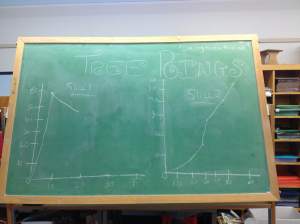
The young dendrochronologists created 2 graphs per tree cookie examined: 1 comparing a tree’s growth over time, and the other comparing the % growth over time.
February 12, 2015: Forest Thursday – Aging Trees

Hallee’s tree ring is a direct representation of her age! Can you figure out how old Hallee is?! (Hint – she’s in first grade!)
Today at Forest Thursday we learned all about tree rings!! We learned that tree growth depends on a variety of factors, including location, surrounding foliage, water, and temperature. We also learned the definition of a very big word – dendrochronology – and why it is important.
We even created our very own tree rings which represented our own ages! Wider rings represent more growth, while narrower rings represent less growth.
If you were a tree, how many growth rings would you have?
February 06, 2015: Science Friday – The Carbon Cycle
Today we learned about the complexities of the carbon cycle! We constructed carbon dioxide molecules with our molecular building kits, we learned about the greenhouse effect, and we even created our own mini Venus-like atmosphere composed of nearly 100% CO2.
We tested the composition of our CO2-heavy atmosphere by exposing a lit match to the air. As we hypothesized, the flame went out! This is because there was little O2 present.
One of the most important lessons we learned today was how important it is to read directions very carefully when conducting science experiments. Some of us got a little too excited (for good reason!) and rushed through the directions, resulting in incorrect steps taken throughout the experiment. When we don’t read directions carefully, we may create inaccurate data or unsafe environments. But it is okay to make mistakes! That is how you learn!
Because of some mistakes we made today, we now understand how vital it is to be patient with science and be concise when performing experimental procedures. When you read the directions thoroughly, your experiment will be as successful and safe as possible. And that’s when science is the most fun.

Woah – I thought there was just baking soda and vinegar in the bag?! Why in the world is it fizzing like that? Maybe it has to do with the fact that an acid and a base are interacting!

Measuring out 200 mL of vinegar…it’s best to be positioned at eye-level to the liquid you are pouring for accuracy.
Next week we will be learning how to count tree rings! See you then!
February 02, 2015: Natural Resources – Phoenix School
For today’s weekly field trip we ventured out of town to examine land affected by recent (2-year old) wildfire events. We learned about different causes and reasons for natural and prescribed fires, and we used the scientific method to create our own experiment.
We compared and tested the soil quality and species diversity of 2 sites: a complete burn site with little to no new-growth and a partial burn site with some new growth.
The results we found matched our hypothesis – hooray!! Want to know what we learned? Ask the students when you see them next!
January 30th, 2015: Science Friday – Weather and Climate
Today was week 3 of Science Friday!! We learned about Earth’s weather and climate systems, and we learned how to differentiate between the two concepts. Oftentimes people mix up the definitions of weather and climate and view them as singular terms, but that is a big misconception. They are not synonymous!
Today in Winston it was a balmy 50 degrees with 100% cloud cover, which is an example of weather. Over the past 30 years, the average January temperature in Winston would be an accurate representation of the area’s climate. Units of time are very important and to overlook them is not very scientific!
The class divided into 5 groups: Water Supply, Plants, Animals & Ecosystem, Energy, Health, and Recreation, and conducted a small research project on their topic’s relation to a changing global climate. After each group discovered new information on their topics, they presented their findings to their fellow scholars! True Scientists!
Next week we will be learning about the carbon cycle!! Stay tuned!
January 29th, 2015: Science Olympiad – Douglas High School
Today we had an extra long 4 hour practice!! We worked on Entomology, bridge building, Wright Stuff, Dynamic Planet, and Disease Detectives. So productive. Whew!
We are making so much progress as a team, and I couldn’t be more proud of every student involved. THANK YOU, young scientists. You are inspiring.
Thank you to all of the community volunteers, parents, and teachers who are volunteering their time and intelligence to make this program as successful as ever!
Go Nerd Herd!
January 28th, 2015: Wilderness Unit – Phoenix Charter School
Today we had a very special guest — Bob Hoehne, longtime Environmental Steward and Umpqua Watersheds Wild on Wilderness (WOW) committee chair — speak in Phoenix School’s Wilderness class.
He shared some stories of his personal experiences in the wilderness we all share, as well as facets of it’s dynamic history and future. Bob’s presentation will aid in the student’s development of their upcoming “Wilderness Anthology” project.
The Phoenix students thank you, Bob!!!
January 23rd, 2015: Science Friday – The Water Cycle
Today we learned about the water cycle! Did you know that most of the water on Earth today existed back when the dinosaurs roamed the planet? We learned the terminology and concepts related to the water cycle itself, including precipitation, sublimation, transpiration, respiration, condensation, energy, physical states, and more.
The students also learned of the importance of using symbols to detail scientific concepts in illustrations, as is shown below.

A student drew this great example of the water cycle in an ocean/mountain setting. Such a complex process was illustrated with such clarity! This is an example of a great scientist (and science teacher) in the making!
We even made our own water cycle in a cup! The young scientists paired up to create their very own mini-water cycle demonstration. They practiced their scientific method skills by creating an initial hypothesis before setting up the experiment, and then recording their observations after their materials were exposed to 45 minutes of sunshine.

The students drew their hypothesis vs. actual observations before discussing the various components of their results.
See you next time!!!
January 16th, 2015: Science Friday – Water Chemistry
Today was the very first Science Friday of 2015! 20 future “Forest Stewards” from McGovern Elementary–with the help of Douglas High School student volunteers–spent 2 hours learning about water’s molecular structure, chemical, and physical properties.
We spent much of the day doing science experiments – it was a little bit wet, but a lot of fun.
We even proved that surface tension exists on the surface of water by floating paperclips. One group of students successfully floated 4 paperclips in 1 cup! Wow!
January 15th, 2015: Forest Thursday – Environmental Conservation

The K-2nd grade group drew a mural of a “Polluted Environment”. It doesn’t look like a very fun environment to live in, does it?
Forest Thursday was great today! We read and analyzed Dr. Seuss’ “The Lorax” and discussed the differences between human “wants” and “needs”. We all need resources, but sometimes we want more than we truly require.
Our environmental resources are not limitless, but sometimes we forget this.
Next Forest Thursday will be in February! See you then, Canyonville YMCA!
Welcome to the Education Blog!
We are starting this blog so we can better document the many exciting educational programming we provide on a daily basis in Douglas County. Umpqua Watersheds provides environmental education opportunities to many schools in the area including McGovern Elementary, Douglas High School, Phoenix Charter School, and the Canyonville YMCA afterschool program. We are so excited to start showing you some of the wonderful things we accomplish every week! Thanks to the students and the fantastic parents in the community for learning and growing with us.




